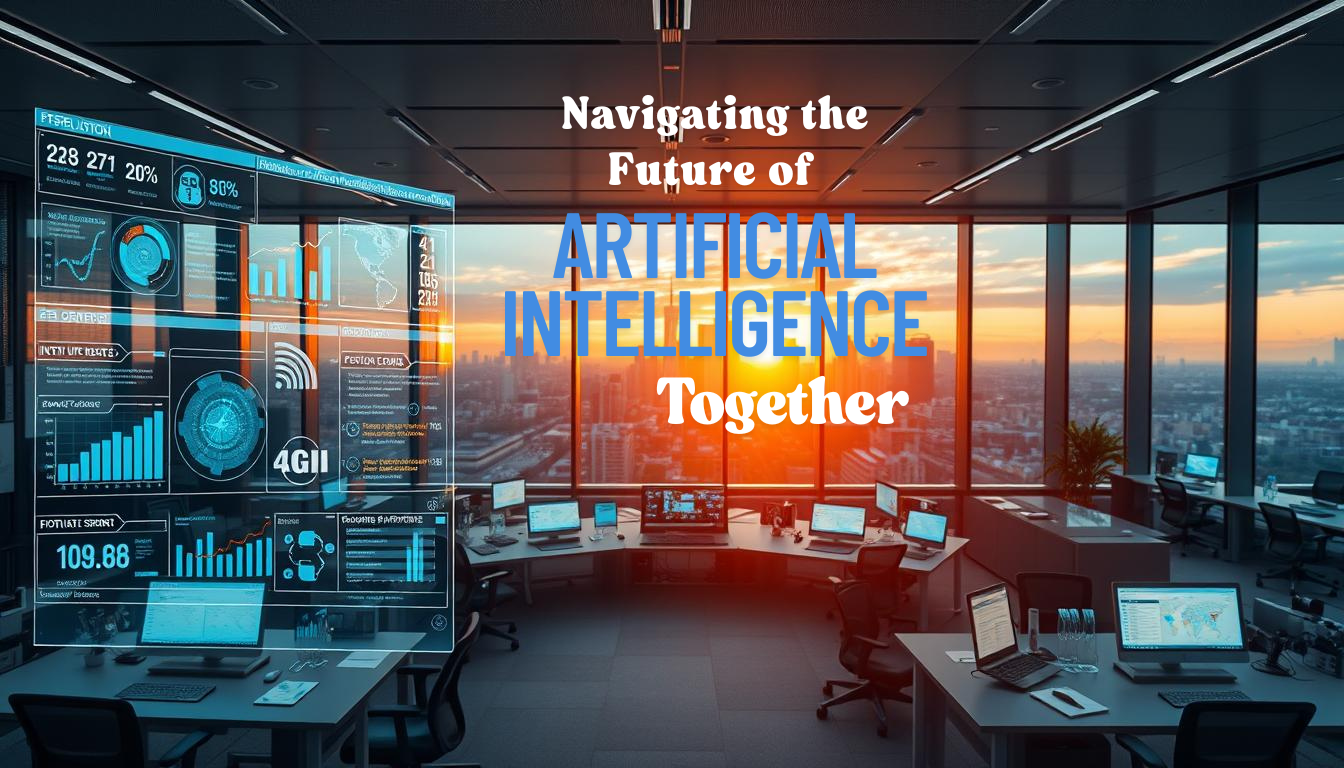Navigating the Future of Artificial Intelligence Together
Did you know that 42% of businesses are already using artificial intelligence (AI)? According to IBM’s 2023 Global AI Adoption Index, this technology is reshaping industries at lightning speed. From automating tasks to powering smart devices, AI’s influence is now deeply woven into our daily lives.

Today, generative AI tools make up 38% of all implementations. These tools can create content, design systems, and even solve problems that were once thought impossible. In just a few short years, we’ve compressed decades of innovation, triggering seismic shifts in fields like healthcare, finance, and manufacturing.
But with great power comes great responsibility. In this article, we’ll explore how AI is transforming sectors around the world—while raising major ethical questions. Ready to dive into the future of AI? Let’s go.
📌 Key Takeaways
- 42% of companies use AI today.
- 38% of AI tools are generative models.
- Tech advancement is 10x faster than it used to be.
- Industries like healthcare, finance, and manufacturing are being redefined.
- Ethical concerns are shaping the future of AI development.
1. The Evolution of AI: From Checkers to ChatGPT
AI’s journey started in 1951 with Christopher Strachey’s checkers program. Since then, progress has been nothing short of astonishing.
Key milestones:
- 1951: First checkers program on the Ferranti Mark I
- 1997: IBM’s Deep Blue beats Garry Kasparov in chess
- 2011: Watson wins Jeopardy!
- 2018: OpenAI launches GPT models
- 2025 (forecast): DeepSeek R1/V3 brings affordable AI to the masses
Today’s generative models—like GPT-4, Claude, and Gemini—can write, code, create images, assist with research, and even help discover new drugs. And this is just the beginning.
2. Why AI Is More Critical Than Ever
AI is moving from lab experiments to real-world impact in record time. As of 2023, 55% of businesses use AI to automate processes and gain efficiency.
Sector adoption rates:
- 🏥 Healthcare: 62% use AI for diagnostics
- 🛒 Retail: 58% apply AI in customer and inventory management
- 🏭 Industry: 71% use AI in quality control
Even governments are on board—more than 60 countries have launched national AI strategies. Innovation cycles that once took decades now unfold in just a few years.
3. AI and the New Age of Automation
Gone are the days of robotic chatbots. Today’s conversational AIs understand context and respond fluidly. For example, MyChart at UC San Diego Health handles 58% of patient inquiries automatically.
AI is also powering predictive analytics, helping factories detect wear and tear before breakdowns and allowing financial systems to catch fraud in milliseconds.
But there are risks too—data leaks, hallucinating models, and critical errors. Secure AutoML platforms and no-code AI solutions are now empowering even small businesses to adopt AI safely.
4. Sectors Undergoing Major Transformation
🩺 Healthcare: Better, faster diagnoses
AI spots patterns invisible to the human eye. It also accelerated vaccine development and supports elderly care through robots like CARMEN.
🏭 Industry: Smarter factories
Predictive maintenance slashes downtime and waste. Smart supply chains adapt in real time to market demand.
💰 Finance: Enhanced security
AI detects fraud, manages risk, and expands access to credit using alternative data.
5. AI and the Job Market: Threats and New Opportunities
By 2028, 44% of today’s skills will be obsolete. While some roles (cashiers, clerks) may disappear, new ones are booming: AI trainers, ethics auditors, and more.
Growing roles:
- +65% increase in AI trainers
- +49% in algorithmic ethics specialists
Universities and companies are ramping up retraining programs to help people transition smoothly into this new landscape.
6. The Ethical Dilemma
Privacy and regulation
The EU, US, and China have vastly different approaches. Without global consensus, data privacy remains fragile. New solutions like watermarking and independent audits are being developed.
Algorithmic bias
AI can unintentionally discriminate. For example, facial recognition errors are more common with darker skin tones. Diverse development teams and fairness audits are now essential.
7. AI and the Climate: Problem or Solution?
Data centers consume huge amounts of power. But AI also helps optimize renewable energy and reduce waste. Google, for instance, boosted wind turbine efficiency by 20% using AI.
Green AI initiatives:
- Underwater server cooling
- Waste reduction through circular economy modeling
- Carbon sink monitoring powered by AI
8. Looking Ahead to 2034
We’re entering an era where personal AI assistants will detect our emotions, tailor our experiences, and predict our health risks with 98% accuracy.
Quantum computing and neuromorphic chips could supercharge AI to new levels. By 2034, most digital content may be AI-generated.
9. The 2040 Horizon: Dystopia or Utopia?
From self-repairing networks and federated learning to AI-assisted space colonization, the possibilities are wild. But so are the risks: deepfake-driven misinformation, AI-powered warfare, and economic inequality.
The future of AI will be shaped by today’s choices—especially in how we govern it.
10. Conclusion: Shaping the Future, Together
AI’s future isn’t just a technical issue—it’s a human one. If we choose transparency, inclusion, and education, we can build a future where AI enhances humanity rather than replaces it.
Let’s commit to an ethical, sustainable, and innovative future. Together.
FAQ
🧠 How has AI evolved over time?
From simple rule-based systems to models that can write, design, and solve complex problems.
📈 Why is AI important now?
It delivers real business value—faster decisions, lower costs, and new opportunities.
🏥 What industries are most affected?
Healthcare, finance, and manufacturing are seeing the biggest transformations.
👩💼 Will AI replace jobs?
Some, yes—but it will also create new ones. The key is to adapt.
⚖️ What are the ethical concerns?
Bias, transparency, and data privacy are major challenges that must be addressed.
🌍 Can AI help the climate?
Yes—when applied properly, AI can reduce waste and optimize renewable energy systems.
🔮 What’s coming by 2034?
Highly personalized AI, predictive medicine, and seamless integration into our daily lives.
🧬 What lies beyond that?
Bold projects combining AI with quantum computing, brain interfaces, and even space exploration.



